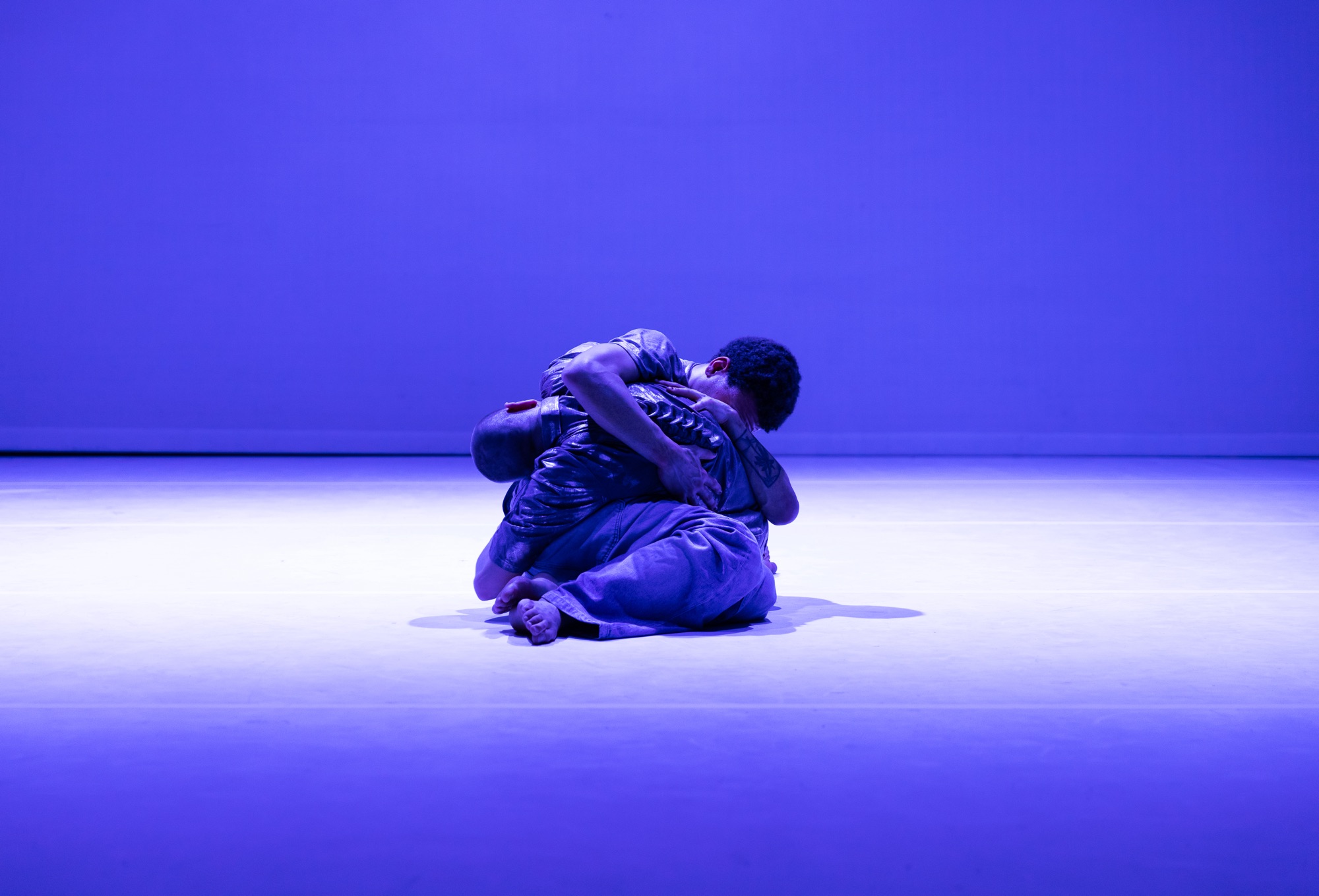Words by Gabriel Levine.
‘I’m finding it quite difficult to keep going,’ sighs one of the two performers in Charlotte Mclean’s newest dance-theatre work Futuristic Folktales, which travelled to Glasgow’s Tramway in April via London, Dundee and Bern. After a sustained sequence of intense movement – a mixture of highland and contemporary dance with elements of breakdance, contortion and shadow-play – Orrow Bell pauses, stumbles and sits down at the side of the stage: ‘I feel exhausted. Could something else take over for a bit,’ they ask Astro Scheidegger, their co-performer, ‘if that’s ok?’
Reproduction, birth and the cycles of life are the focal point of Futuristic Folktales. The choreography is suffused with circles and loops, such as the rings that Bell makes with their arms and tries unsuccessfully to slip through, or the breakdance-inspired spins that Scheidegger repeatedly returns to. In the atmosphere of constant, cyclical energy, this sudden admission of weariness has a powerful effect, as if a link in the chain has suddenly snapped. ‘I feel like everything’s just going and going,’ says Bell, ‘and I sort of don’t really know how to slow it all down.’ They stop for a moment to catch their breath and reconsider how to move forward, to figure out where to go next.
There is a sense of the provisional that pervades Futuristic Folktales – an empty set, simple costumes, occasional interruptions and appeals to the audience – which gives us the intimate feeling of attending a rehearsal. The performance is discontinuous and impressionistic, addressing concerns such as reproductive rights and identity through suggestive movement.
When the performers speak at length, which happens mostly towards the start of the show’s concise hour, they explore the idea of the ‘first womb,’ both as a material reality and as an idea that unites the whole of humanity. ‘Womb water, womb plant, womb rock,’ they chant, moving ecstatically between the pastoral and the technological: ‘cybernetic womb, holographic womb, hypersonic womb’.

The script itself aims for an all encompassing universality that unfortunately evades its reach. Repeated platitudes like ‘eight-billion second chances’ ring hollow in the face of the immediate political and environmental crises that cannot be far from the audience’s minds. The inventive movement does much of the conceptual heavy-lifting, as well as the wonderfully utilised non-verbal sounds. Groans, grunts and moans are heard throughout, especially in a brilliantly beguiling sequence near the beginning in which the performers act out giving birth to each other in a variety of positions. Scheidegger’s unrestrained wailing in this section cuts to the core, and the glacial pace at which the performers move pulls us beyond the region of comfortable viewing.
These techniques coalesce most powerfully in the passage that immediately follows Bell’s request for ‘something else,’ when Scheidegger offers up the wordless ‘story of the oak tree’. Replicating the lifecycle of a tree through expressive but constrained gestures, Scheidegger mimics growth from seed to sapling, from towering trunk back to tiny seed. Particular emphasis is placed on the sucking sound of roots and the creaking of the branches, lending an undeniable presence and physicality to the slowest of processes. He loudly thumps to the floor each time the cycle starts over.
Throughout, synthetic drones are layered between the bleating of bagpipes, perhaps most concisely encapsulating the clash between utopic futurity and conservative traditions that is hinted at in the title.
The sound, orchestrated by Malin Lewis, is a powerful feature of the performance as a whole. Mclean has spoken of the bagpipe as an ‘imagined womb,’ which explains its prominence in the score even while the elements of highland dance can seem slightly incongruous at points. Neither the script or the choreography of Futuristic Folktales ever seriously engages with either the uncertainties of the future or the ‘folk’ aspects of our shared past, instead appealing to a nondescript space of timelessness against which the militaristic gestures of highland dance bristle awkwardly. Their appearance is hardly unwelcome, however, and these traditional elements remind us of the collaborative approach Mclean, Bell, and Schiedegger took towards devising the choreography, each bringing in techniques and movements from their respective fields.

Connections, links, circles: it is what draws people together that drives the energy behind Futuristic Folktales. The final, achingly sweet sequence consists of Bell and Scheidegger sat, side by side on the floor, their faces buried in each other’s shoulders, their arms wrapped round and pulling tight as the stage-lights slowly rise and fall.
Creative Team:
Concept and Director: Charlotte Mclean (she/her)
Creative Producer: Helen McIntosh (she/her)
Writer: Nelly Kelly (they/them)
Composer: Malin Lewis (they/them)
Lighting Designer & Production Manager: Emma Jones (she/her)
Costume Designer: Alison Brown (she/her)
Dramaturg: Rob Evans (he/him)
Performer: Astro Scheidegger (he/him)
Performer: Orrow Bell (they/them)
Technical Manager: Lynn Wiseman (she/her)
PR (UK): Storytelling PR
PR (Switzerland): Camille Jamet (she/her)
International Consultant: Nadja Dias (she/her)
Project Collaborators: Annable Cooper (she/her), Amarnah C Osajivbe-Amuldun (she/her), Chanai Bradley Fofanah (she/her), Domenico Angarano (he/him), Gina Lorenzen (she/her), Ichai Carre (he/him), Irodriel Costello (they/them), Jac Reichel (they/them), Kate Hall (she/her), Kirsty Nicolson (they/them), Lucy Suggate (she/her), Molly Scott Danter (they/them), Neil Dewar (he/him), Rebekka Hoelzle (she/her), Rhys Dennis (he/him), Sunniva Moen Rørvik (they/them)
